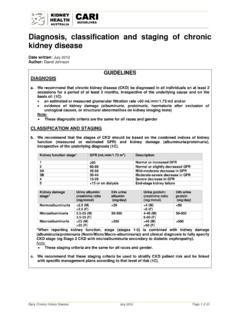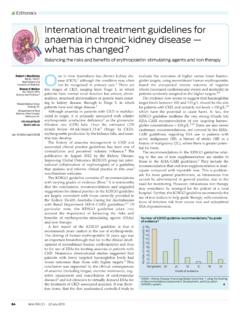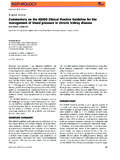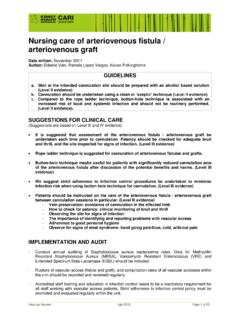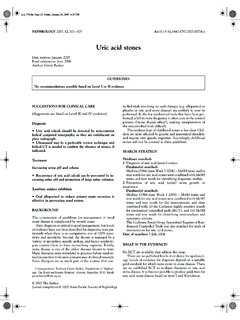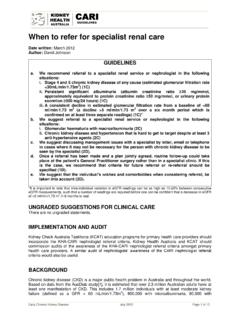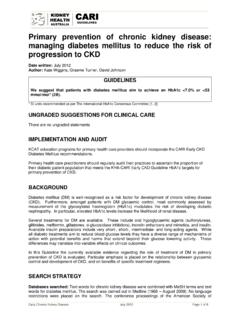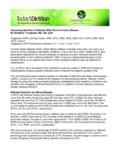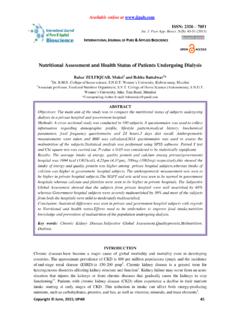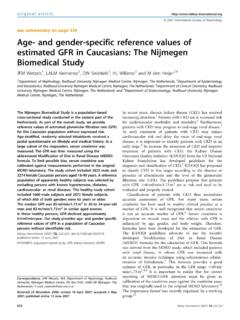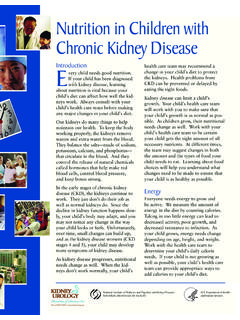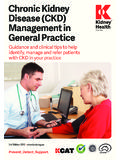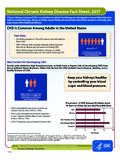Transcription of Vitamin D therapy (supplementation) in early …
1 _____ early chronic kidney disease July 2012 Page 1 of 12 Vitamin D therapy ( supplementation ) in early chronic kidney disease Date written: July 2012 Author: Maria Chan, David Johnson GUIDELINES a. We suggest Vitamin D deficiency (25-hydroxyvitamin D < nmol/L) and insufficiency (25-hydroxyvitamin D nmol/L), if present, be corrected using treatment strategies recommended for the general population (2C) as outlined below: Vitamin D found in foods: b. We suggest a daily oral intake (total) of Vitamin D for patients with early chronic kidney disease who are not exposed to direct sunlight for at least 1-2 hours per week, as per NHMRC recommendations (2D). 19-50 years 5 g (200 IU) 51-70 years 10 g (400 IU) >70 years 15 g (600 IU) (where 1 g = 40 IU) Note: Few foods contain significant amounts of Vitamin D, the major sources being fatty fish (salmon, sardine, herring and mackerel), liver, eggs and fortified foods, such as margarine and some varieties of low-fat milk.
2 There are limited data on Vitamin D content of local foods. It is exceedingly difficult to obtain sufficient Vitamin D from the diet alone. Sun exposure for Vitamin D: c. To strike a balance between achieving adequate Vitamin D from sun exposure and avoiding the risk of skin cancer, we suggest that the recommendations made in the joint positions statements of the Australian and New Zealand Bone and Mineral Society, Osteoporosis Australia, the Australasian College of Dermatologists and the Cancer Council of Australia be applied to patients with early chronic kidney disease (2D): Fair-skinned people can get enough Vitamin D in summer from a few minutes of sunlight on their face, arms and hands before 10am or after 3pm on most days of the week.
3 In winter in southern regions of Australia, when UV radiation levels are below 3, people need about two to three hours of sunlight to their face, arms and hands over a week. Note: Endogenous synthesis (activation) of Vitamin D is reduced in chronic kidney disease , but it is not sure if extended sunlight exposure could overcome such insufficiency. Vitamin D supplementation : d. We recommend a prescription of Vitamin D therapy for early chronic kidney disease patients with secondary hyperparathyroidism, as it has been shown to be effective in suppressing elevated levels of parathyroid hormone (PTH) (1A). Note: However, there is insufficient evidence to determine whether this intervention improves patient-level outcomes ( bone pain, fracture, a need for parathyroidectomy, progression to renal replacement therapy , cardiovascular events or all-cause mortality).
4 These potential benefits of Vitamin D therapy must be weighed against its potential deleterious effects, including hypercalcaemia, hyperphosphataemia, vascular calcification, adynamic bone disease and accelerated progression of CKD. e. We recommend that early chronic kidney disease patients on Vitamin D therapy have their calcium, phosphate, PTH, alkaline phosphatase and 25-hydroxy- Vitamin D levels monitored regularly (1C). _____ early chronic kidney disease July 2012 Page 2 of 12 UNGRADED SUGGESTIONS FOR CLINICAL CARE There are no ungraded statements. IMPLEMENTATION AND AUDIT Clinicians should regularly audit 25-hydroxyvitamin D levels and Vitamin D supplementation in their practices.
5 The association of these practices with clinical outcomes, such as chronic kidney disease mineral and bone disorder (CKD-MBD), cardiovascular events and renal function decline, should be evaluated. BACKGROUND The current guideline is focused on Vitamin D therapy in CKD stages 1-3. Vitamin D deficiency is not uncommon in the general and CKD populations[1, 2] Common factors causing low serum Vitamin D levels are (1) reduced exposure to sunlight, (2) low dietary Vitamin D intake from foods, such as Vitamin D2 or Ergocalciferol from plant sources, and Vitamin D3 or cholecalciferol from animal sources and (3) individuals with increased melanin content of the skin. In the CKD population, both Vitamin deficiency and insufficiency occur.
6 As GFR falls, hydroxylation/ activation of Vitamin D is impaired, then hyperparathyroidism develops and the increased PTH acts on the bones to resorb calcium. Retention of phosphate may begin to occur when renal function falls below 80% of the normal. Changes in any of these laboratory values may begin in stage CKD 3, but the presence, rate of change and severity of these abnormal parameters are highly variable among individuals. In a study of 168 consecutive new referrals of patients with stages 2-5 CKD to a CKD clinic, Ravani et al[3] observed that both 25-hydroxyvitamin D and 1,25-dihydroxyvitamin-D levels were significantly, inversely associated with eGFR. Consequently, the prevalence rates of Vitamin D insufficiency and deficiency increased from 62% and 25% in stage 2 CKD to 88% and 56% in stage 5 CKD.
7 Similarly, a cross-sectional study of 15,068 adults participating in the Third National Health and Nutrition Examination Survey (NHANES) reported a strong, inverse association between albuminuria and serum 25-hydroxyvitamin D concentrations[4]. There is considerable debate and controversy regarding the definitions of Vitamin D deficiency and insufficiency, the optimal measurement of Vitamin D levels and even the appropriate terminology used to describe low Vitamin D status (deficiency, insufficiency, inadequacy, and hypovitaminosis D)[5]. These difficulties are compounded by 25(OH)D assay variability [5]. In this review, we have defined Vitamin D insufficiency and deficiency as serum 25-hydroxyvitamin D levels of nmol/L and < nmol/L, respectively.
8 Vitamin D supplementation has been suggested as a possible strategy for improving bone and cardiovascular health in the general population[6-8]. This review examines the evidence pertaining to the clinical benefits of Vitamin D supplementation in stages 1-3 CKD. SEARCH STRATEGY Databases searched: Text words for chronic kidney disease were combined with MeSH terms and text words for Vitamin D, calcitriol, CKD-MBD. The search was carried out in Medline (1966 January, 2010) and Cochrane Renal Group Specialised Register of Randomised Controlled Trials. Searches were limited to adult human studies and to studies published in English. An updated search was conducted in Medline (2010 June 2012).
9 Text words and MeSH terms used were the same as those from the previous search. Date of search/es: 2 February 2009: 25 January 2010: June 2012 _____ early chronic kidney disease July 2012 Page 3 of 12 WHAT IS THE EVIDENCE? There are no published studies on the effect of dietary Vitamin D intake and sunlight exposure on CKD-MBD in stage 1-3 CKD patients. Vitamin D therapy has traditionally been used in CKD patients to suppress secondary hyperparathyroidism and to correct deficiency states. More recently, a number of observational studies have observed an association between Vitamin D supplementation (either with paracalcitol, 1,25-dihroxyvitamin D or 1-hydroxyvitamin D) and improved survival of patients with end-stage renal disease [9-13].
10 Furthermore, Ravani et al[3] identified significant, independent, inverse associations between serum 25-hydroxyvitamin D levels (but not 1,25-dihrdroxyvitamin D levels) and both progression to end-stage renal failure and mortality. A subsequent systematic review and meta-analysis of 10 prospective observational studies involving 6,853 CKD patients demonstrated that higher serum 25-hydroxyvitamin D levels were associated with significantly improved survival [14] However, such studies do not establish causality and may well be explained by indication bias with residual confounding. A systematic review by Palmer et al. [15] indicated that there are not sufficient data to determine the effect of Vitamin D compounds on mortality and cardiovascular outcomes in the non-dialysis CKD population.


